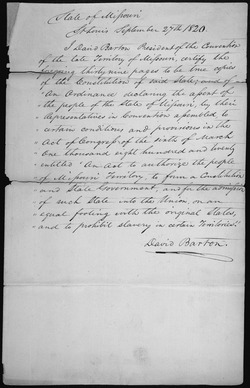Constitution of Missouri
The Missouri Constitution is the state constitution of the state of Missouri in the United States. It is the highest law which forms the laws and government of Missouri. It is subject only to the United States Constitution, and the people of Missouri. The fourth and current Missouri Constitution was adopted in 1945. It provides for three branches of government. The legislative branch is the Missouri General Assembly). The executive branch is headed by the Governor of Missouri. The judicial branch is the Supreme Court of Missouri and the Missouri state courts. It also sets up local governments in the form of counties and cities.
History
The first constitution was written in 1820 in only 38 days.[1] In 1845 the state outgrew its own constitutional limits on creating new counties. A second convention was called in Jefferson City and met from November 1845 until January 1846.[2] But voters would not ratify the proposed constitution in August 1846.[2] The Missouri Constitutional Convention was elected to decide on the issue of secession. But no changes were made to the constitution.[a]
In 1865, delegates met in St. Louis from January 6 to April 8, 1865 to form a new constitution.[2] It was called the “Draconian Constitution”[b] and required an oath of loyalty to the Union.[2] It was ratified on June 6, 1865.[2] In 1867, the Supreme Court of the United States struck down the loyalty oath in Cummings v. Missouri (71 U.S. 277 (1867)).[2]
Missouri citizens approved a new fourth constitutional convention in 1874.[2] Delegates met in Jefferson City from May 5th to August 2nd, 1875. The changes to the Constitution were mainly about schools. It required 25% of the general revenue be used to support public schools.[2] It also required separate schools for children of African descent.[2] The constitution was ratified on October 30, 1875.[2]
The fifth constitutional convention met in Jefferson City from May 15, 1922 to November 6, 1923.[2] But instead of a new constitution the convention proposed 21 amendments.[2] But the voters refused to approve all 21 amendments at the special election called for February 26, 1924.[2] As a result, none of the amendments were ratified.[2]
The fifth convention was called in Jefferson City on September 21, 1943.[2] The new constitution was approved by the delegates on September 28, 1944 and ratified on February 27, 1945.[2] It has been amended several times since then.[2]
Notes
- ↑ The deposed governor, Claiborne Fox Jackson along with the deposed pro-Confederate members of the legislature met at Neosho, Missouri on October 28, 1861.[3] They passed a law for Missouri to secede from the Union on November 2. But the legislature did not have legal recognition or control of Missouri at the time. The so-called rump legislature did not have a quorum (minimum number of legislators to officially conduct business).[4] The constitution at the time required a minimum of 67 members of the House and 17 members of the Senate to be legal.[4] At Neosho there were only 39 members of the House and 10 members of the Senate who were present.[4]
- ↑ Also called the Drake convention after the Radical Republicans Charles D. Drake, who heavily influenced the convention.[5] The constitution included what became known as the "Ironclad" or "Kucklebur" oath.[6] Teachers, lawyers, clergy and voters, because of their influence, were required to take an oath saying they had not committed any disloyal acts.[6]
References
- ↑ Chief Justice Michael A. Wolfe (September 9, 2005). "Law Matters: A Celebration of Two Constitutions". Supreme Court of Missouri. Retrieved 8 June 2016.
- ↑ 2.00 2.01 2.02 2.03 2.04 2.05 2.06 2.07 2.08 2.09 2.10 2.11 2.12 2.13 2.14 2.15 2.16 "Missouri Constitutions, 1820-1945". Missouri Digital Heritage. Retrieved 8 June 2016.
- ↑ "Missouri Ordinance of Secession Passes in Neosho". Civil War on the Western Border. Retrieved 8 June 2016.
- ↑ 4.0 4.1 4.2 "Missouri; The Bogus Secession Legislature". The New York Times. 3 February 1862. Retrieved 8 June 2016.
- ↑ Dictionary of Missouri Biography, eds. Lawrence O. Christensen; William E. Foley; Gary Kremer (Columbia: University of Missouri Press, 1999), p. 256
- ↑ 6.0 6.1 "Constitution of 1865 - Drake Constitution". The Missouri History Museum. Retrieved 9 June 2016.
Other websites
- Missouri Constitution Archived 2016-06-08 at the Wayback Machine
